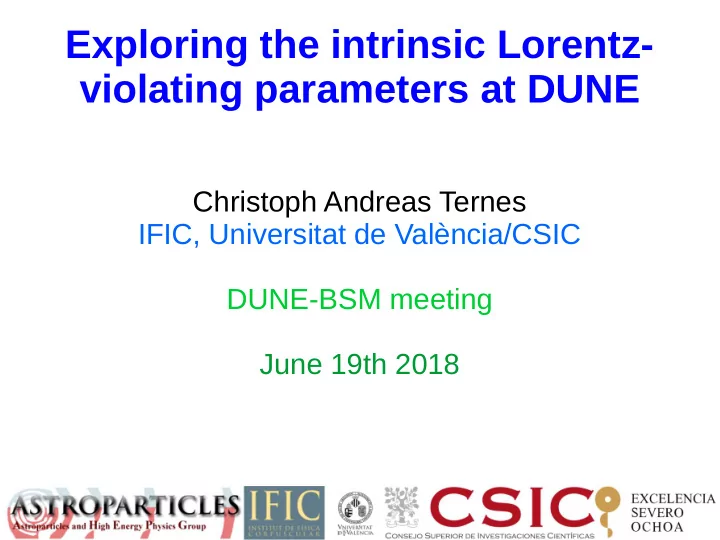

Exploring the intrinsic Lorentz- violating parameters at DUNE Christoph Andreas Ternes IFIC, Universitat de València/CSIC DUNE-BSM meeting June 19th 2018
Motivation ● Observation of violation of P symmetry in weak interactions
Motivation ● Observation of violation of P symmetry in weak interactions ● Observation of violation of CP symmetry in CKM-matrix and (possibly) in PMNS-matrix
Motivation ● Observation of violation of P symmetry in weak interactions ● Observation of violation of CP symmetry in CKM-matrix and (possibly) in PMNS-matrix ● What about a violation of CPT?
Motivation ● Observation of violation of P symmetry in weak interactions ● Observation of violation of CP symmetry in CKM-matrix and (possibly) in PMNS-matrix ● What about a violation of CPT? ● Violation of CPT can be induced through violation of unitarity, locality or Lorentz invariance
Motivation ● Observation of violation of P symmetry in weak interactions ● Observation of violation of CP symmetry in CKM-matrix and (possibly) in PMNS-matrix ● What about a violation of CPT? ● Violation of CPT can be induced through violation of unitarity, locality or Lorentz invariance ● We focus here on the violation of Lorentz invariance
Motivation ● Introduce Lorentz violation effectively in form of the Standard model extension (SME)
Motivation ● Introduce Lorentz violation effectively in form of the Standard model extension (SME) ● In the SME the neutrino sector is described by with
Motivation ● Introduce Lorentz violation effectively in form of the Standard model extension (SME) ● In the SME the neutrino sector is described by with ● The Lorentz-violating operator can be decomposed into Unobservable
Motivation ● Introduce Lorentz violation effectively in form of the Standard model extension (SME) ● In the SME the neutrino sector is described by with ● The Lorentz-violating operator can be decomposed into Induce effective Hamiltonian for neutrino mixing
Motivation ● The effective Hamiltonian can be decomposed into 3x3 blocks: Neutrino mixing
Motivation ● The effective Hamiltonian can be decomposed into 3x3 blocks: Antineutrino mixing
Motivation ● The effective Hamiltonian can be decomposed into 3x3 blocks: Neutrino-antineutrino mixing
Motivation ● The effective Hamiltonian can be decomposed into 3x3 blocks: Standard oscillations
Motivation ● The effective Hamiltonian can be decomposed into 3x3 blocks: CPT-odd Lorentz violation parameters
Motivation ● The effective Hamiltonian can be decomposed into 3x3 blocks: CPT-even Lorentz violation parameters
Motivation ● We focus on the isotropic part of the Hamiltonian. We then obtain with
Motivation ● We focus on the isotropic part of the Hamiltonian. We then obtain with ● The second matrix is highly constrained by atmospheric and solar data. We focus only on the first matrix
Motivation ● Comparing with one finds a correspondence
Motivation ● Comparing with one finds a correspondence ● Anyway, NSI is basically an exotic matter effect while CPT violation considered here is an intrinsic effect, present even in vacuum
Motivation ● Comparing with one finds a correspondence ● Anyway, NSI is basically an exotic matter effect while CPT violation considered here is an intrinsic effect, present even in vacuum ● To incorporate this type of Hamiltonian we have modified the already existing GLoBES- extension snu.c
Results ● The oscillation probabilities are modified
Results ● The oscillation probabilities are modified
Results ● This modified probabilities lead to constraints on the new parameters
Results ● This modified probabilities lead to constraints on the new parameters ● The sensitivity to the standard parameters gets worse
Results ● Correlations among the new parameters
Results ● Correlations among the new parameters ● Effects of certain parameters can cancel each other
Results ● We can calculate the profiles of each of the new parameters….
Results ● ….and obtain the possible future bounds
Results ● ….and obtain the possible future bounds Improve bounds by a factor of around 5
Results ● ….and obtain the possible future bounds No improvement here
Results ● ….and obtain the possible future bounds New bounds here!
Bibliography ● G. Barenboim, M. Masud, C.A. Ternes, M. Tórtola (2018), 1805.11094 ● J. S. Diaz (2016), 1609.09474 ● J. S. Diaz (2015), 1506.01936 ● V. A. Kostelecky, M. Mewes, Phys. Rev. D69, 016005 (2004), hep-ph/0309025 ● A. Kostelecky ,M. Mewes, Phys. Rev. D85, 096005 (2012), 1112.6395
Thank you!
Recommend
More recommend